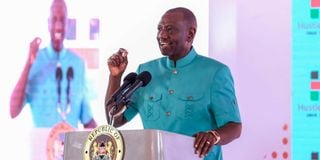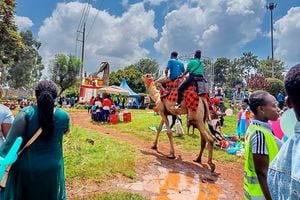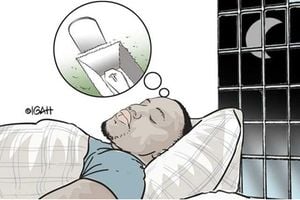
President William Ruto delivers his speech during first anniversary celebrations of Hustler Fund in Nairobi.
The past year has seen an implosion in President William Ruto’s UDA in the Mt Kenya region and its diaspora. Political outbursts have revealed that the key figures moving forward will be former Deputy President Rigathi Gachagua and political operatives close to the Presidency.
The extent to which Gachagua has expressed his displeasure at being ousted without a hearing has left the Ruto-Mt Kenya political marriage irreparably damaged. Amidst this fallout, what stands out is the growing excitement surrounding Gachagua’s public appearances in the Mountain and its diaspora.
State-sponsored attacks in meetings have further bolstered his resonance with the excesses of the Ruto regime. The question now is how this will affect Ruto’s support in the region.
To answer, it is useful to analyse Mt Kenya’s electoral history over the past five elections. What influences its electoral choices?
A study of the last elections since 1992 reveals that the “politics of victimhood” has been a key determinant in the past two decades.
Here’s how: In 1992, Kenneth Matiba defeated Mwai Kibaki in Mt Kenya, drawing a passionate following, particularly in Kiambu and Murang’a, with 1.4 million votes against Kibaki’s 1 million. Matiba became a symbol of opposition to the Moi regime, especially after his hospitalisation in London fuelled the narrative of oppression.
By 1997, Kibaki took over the mantle, with a near-endorsed victory in Mt Kenya, but still lost to Moi in an ethnically charged election.
In 2002, Kibaki capitalised on the sympathy generated from a car accident three months before the election, portraying himself as a victim of Moi’s regime and winning by a landslide in his backyard.
In 2007, Kibaki again positioned himself as a victim of opposition plotting, with Raila Odinga threatening to bring down his government.
The mobilisation in Mt Kenya focused on protecting “their government” from external forces. In 2013, the ICC case against Uhuru Kenyatta served as the perfect example of “politics of victimhood.” Voters viewed the Hague process as a form of colonial aggression.
Similarly, in 2017, the mobilisation in Mt Kenya centred around protecting the government from Raila Odinga’s threat.
This time, the victimhood was about safeguarding their man and ensuring economic stability. In 2022, the perceived betrayal of William Ruto by the Kenyatta administration made him the symbol of State oppression.
The backtracking on Kenyatta’s pledge to support Ruto in the succession race was seen as betrayal. Ruto’s 3.6 million votes in Mt Kenya were a vote for “the oppressed” and against betrayal. Since the Mau Mau era, Mt Kenya has had a deep aversion to betrayal, punishing it ruthlessly.
As a result, the 2027 election will likely be determined by who is seen as the victim of oppression. With Gachagua expected to outline his 2027 plans soon, 2025 will undoubtedly be a year of major political decisions, shaping the path to end Kenya Kwanza’s rule. It will be a one-term regime!
Hon Ngogoyo is the UDA MP for Kajiado North









